 Most viewed - JAPAN 日本 Most viewed - JAPAN 日本 |

Sumo figurines.307 views
|
|

Kiba Kakunori Square Log Rolling, Tokyo307 viewsHeld in mid-Oct. at Kiba Park, Tokyo.
More pictures here
|
|
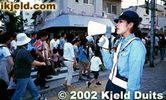
The 2002 World Cup season was one of the most memorable and frenzied times in Japan. The whole country went crazy over soccer, especially while watching the Japan team.306 views
|
|

Laughing Maiko. Another card to cheer up the men at the front line.304 views
|
|

Box seat for two.303 views
|
|
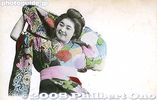
Her name has been a mystery, but I have come across hard evidence that she was a geisha named "Tokimatsu." But I will forever call her the "Laughing Geisha."303 views
|
|

Another shot of her picking tea leaves.302 views
|
|

Crowd outside the Kokugikan await their favorite wrestlers.301 views
|
|

Drawing water from a well.297 views
|
|

Sumo elders in the front row295 views
|
|

Woman and flower patch. Same woman as in the preceding postcard.295 views
|
|
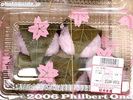
Sakura mochi with edible leaves294 views
|
|

Baruto, from Estonia, at the center. He's well on his way to become Ozeki. There are many foreign sumo wrestlers. Unfortunately, there are none from Hawaii. Mostly Europeans and Mongolians.294 views
|
|

Laughing Geisha in the rain. There's a horse in the background. Maybe she's watching a parade. The ground looks wet.292 views
|
|

Wrestlers wait until everyone is on the ring. Notice that Takamisakari (second from the left) and the rikishi on the far right have almost the same aprons. They will serve as the sword bearer and dew sweeper for the yokozuna ring-entering ceremony.291 views
|
|

The striking yokozuna upset makes the crowd go wild as they throw zabuton cushions in glee.289 views
|
|
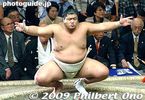
Musoyama (in Sept. 2004).288 views
|
|

Girl at fence. Her posture is crooked, but somehow this photo looks nice. She's not sensationally attractive, but she's photogenic and comes across well. She also appears in the preceding postcard.286 views
|
|

"Japs" on hand-painted Mt. Fuji card. The message on this card reads: "Fujiyama, the mt. (mountain) the Japs worship. Been seeing Yokohama in a jinrichisha (rickshaw). Feb. 14."285 viewsThis person apparently learned a few Japanese words like "jinrikisha" which means "human-powered vehicle" that is the rickshaw. And the term "Japs" has been around well before World War II.
|
|

Laughing Geisha with fan. There are two Yokohama postmarks on this card. One in Japanese (over the stamp) and one in English. The actual card is more yellowed and almost brown, but I bleached it with Photoshop.283 viewsThere are two Yokohama postmarks on this card. One in Japanese (over the stamp) and one in English. Japanese postmarks have the date in the Year-month-day format. And English postmarks have it in the Day-month-Western year format. As you may know, Japan bases its years on the Emperor's reign. In the Japanese postmark, you can see "36" for the year. That's not 1936, but Meiji 36 that corresponds to 1903. Besides the Meiji Period (1868-1912), there's the Taisho Period (1912-1926) and the Showa Period (1926-1989). Since the Japanese postmark only indicates the last two digits of the year, it can be a pain to figure out which period the year belongs to. In most cases, we can figure it out with the stamp or type of postcard back.
|
|

Snow cone with ice cream281 views
|
|

Woman with flowers. She's wearing two rings on her left hand. She looks like a wife alright. How can you tell? Well, her kimono has a plain design, and the word "married" is written on her face.275 views
|
|

274 views
|
|

He stomps the ground to drive away evil.274 views
|
|
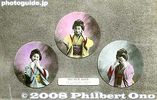
See, hear, nor speak no evil.272 views
|
|

He extends his arms to show that he conceals no weapons. I'm not too crazy about the way Asashoryu does the dohyo-iri though. A few little details make it less dignified.270 views
|
|

Laughing Geisha with baby. She's nicely posed, and you can even see the baby's face. But the color of her kimono is somewhat drab. A mother (or married woman) does not and need not wear a colorful kimono.269 views
|
|

Door to arena.268 views
|
|

Passing out programs267 views
|
|

Lecture classroom (previously used as a dining room for chanko-nabe during tournaments). 相撲教習所259 views
|
|

Udon with raw egg259 views
|
|
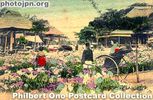
Iris Garden at Horikiri, Tokyo. This card is made of balsa wood. It shows a woman arriving at the garden in a rickshaw. I've seen this photo printed on paper postcards as well. The garden still exists in Tokyo and it's still famous for irises.259 viewsSee photos of the garden today. It's still famous for irises that bloom in June. Hand-colored postcard.
|
|

Crowd enters the Kokugikan for Musashimaru's retirement ceremony on Oct. 2, 2004.258 views
|
|

The 2nd World Baseball Classic's Asia Round was held in March 2009. This game was between Korea and China on March 8, 2009 at Tokyo Dome.253 views
|
|

Kotooshu sits on his own cushion at ringside before his bout.251 views
|
|
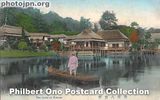
Tea house garden in Hikone, Shiga. This cozy Japanese garden has tea houses. It is directly behind Hikone Castle in Shiga Prefecture. Hikone Castle was the home of Naosuke Ii, the high official who met Commodore Perry.249 viewsToday, this garden still looks pretty much the same. It was even used for a garden scene in the TV mini-series "Shogun." See photos here.
|
|

Kokugikan ticket office (right). Ticket prices range from 2,100 yen to 14,300 yen.247 views
|
|

247 views
|
|

Entrance lobby. At the end of the lobby is a trophy showcase. On the last day of the tournament, the tournament winner will walk through here to his car for a victory parade amid a large crowd.245 views
|
|

Kokugikan ticket office. Cheap tickets costing 2,100 yen are sold every day of the tournament, but sell out fast by noon or so.244 views
|
|

Sumo wrestlers enter through a side entrance. Fans wait for their favorite wrestlers.243 views
|
|

243 views
|
|

At the gate, you might see a famous former wrestler (like former Takamiyama from Hawaii, now Stablemaster Azumazeki) taking your ticket.242 views
|
|

Laughing Geisha looking out. The card is postmarked 1903 from Yokohama. The actual card is more yellowed and almost brown, but I bleached it with Photoshop.241 views
|
|
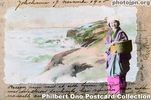
Laughing Geisha on Shore. It's kind of strange to see her at the beach but dressed to pick tea leaves. The message on this postcard was written in French, dated 1905.241 views
|
|
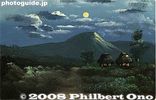
241 views
|
|
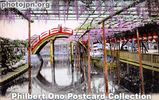
Kameido Tenmangu Shrine, Tokyo. Famous since the Edo Period for wisterias, this shrine has been a popular subject for woodblock artists and early photographers. The wisterias bloom around late April. The shrine is near Kameido Station on the Sobu Line.241 viewsThe shrine is near Kameido Station on the Sobu Line in Tokyo. Hand-colored.
|
|
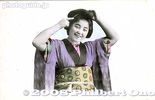
Combing her hair.238 views
|
|

Freshly pounded mochi with azuki bean paste237 views
|
|

Oil-painted card of Mt. Fuji 2. Another postcard oil painting of Mt. Fuji.237 views
|
|

Way to Kokugikan. The guarded side gate on the right is for sumo wrestlers.236 views
|
|
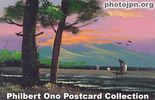
Painting by high school girl? This is my only oil-painted card that has a message and postmark (1910 from Nagasaki). It was addressed to a lady in Alameda, California and says in English that the card was hand painted by a Japanese high school girl.236 viewsWhether this is true or not, I don't know. But the painting style of this card and the others you see here are the same. (I bought them as a set.)
|
|

The chairman of the Japan Sumo Association (shown here is Kitanoumi) greets the crowd and thanks everyone for coming.236 views
|
|

Asashoryu performing the yokozuna dohyo-iri or ring-entering ceremony. There are two styles of the yokozuna dohyo-iri. One is the Unryu style which Asashoryu performs. One hand is on his hip as he rises here. 雲龍型236 views
|
|

Kaki-fry teishoku or fried oysters in a complete meal.234 views
|
|

He claps his hands to get the attention of the gods. 横綱土俵入り234 views
|
|

Corridor and souvenir shops.233 viewsA corridor encircles the arena.
|
|

Omi beef231 views
|
|
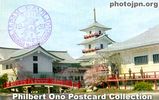
Japan Pavilion at Golden Gate International Expo, 1939. In 1939, the Golden Gate International Exposition was held in San Francisco, California's Treasure Island from February 19, 1939 to October 29, 1939. The expo theme was "Pageant of the Pacif231 viewsPacific Rim countries participated with pavilions having distinctive architecture, landscape, and art. The Japan Pavilion looked quite elaborate with a pagoda, Japanese-style bridge, and two large temple-like buildings.
It was a peaceful gathering of nations and it's sad that only two years later, Japan and America were at war with each other.
|
|

Sumo mural in lobby.230 views
|
|
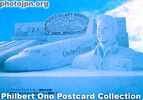
1993 Sapporo Snow Festival. In Sept. 1992, US-Japan relations literally reached new heights with Mamoru Mohri becoming the first Japanese to fly on a US Space Shuttle.229 viewsOn board the Endeavor, Mohri worked on numerous Skylab experiments as a payload specialist during the eight-day mission. He even conducted a "space classroom" with kids in Japan via a live TV broadcast.
This postcard shows the snow sculptures of the Space Shuttle Endeavor, the mission's patch, and a bust of Mohri built for the 44th Sapporo Snow Festival held in Feb. 1993 in Sapporo, Hokkaido. On the left side of the sculpture, you can see ice slides for children.
|
|
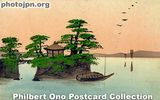
Oil-painted card of Matsushima. Matsushima is a picturesque group of pine tree islands near Sendai, Miyagi Pref. The island pictured is one of the main islands and a major tourist stop.229 viewsAlong with Amanohashidate in Kyoto and Miyajima in Hiroshima, Matsushima is known as one of the three most famous views of Japan (Nihon Sankei).
|
|

Chanko nabe, a meat and vegetable stew eaten by sumo wrestlers. Served at the Ryogoku Kokugikan during sumo tournaments.224 views
|
|

Nameplates of tournament winners on Emperor's Cup223 views
|
|

The sign reads "Physical body, Technique, Heart." What you need to succeed in sumo.223 views
|
|

Sumo Museum. Open only during tournament days. Free admission.220 viewsThe wall on the left show portraits of all the yokozuna in the modern era.
|
|

Kokugikan219 views
|
|

Next to the chanko dining room is a sumo ring for practice and deliberation exhibition matches.218 views
|
|
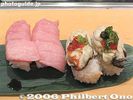
Toro and oyster (kaki) Sushi218 views
|
|

Sumo wrestler and sumo stable banners217 views
|
|

Sashimi donburi217 views
|
|

During a sumo exhibition tour in the US, first lady Nancy Reagan rejected having the yokozuna ring-entering ceremony performed in the Rose Garden of the White House. It was performed at the State Department instead with Secretary George Schultz attending.217 views
|
|
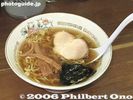
Ramen216 views
|
|
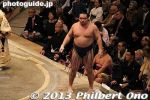
Ozeki Kakuryu in an 2013.216 views
|
|

The sumo matches have five judges (shinpan), dressed in formal black kimono, sitting on each of the four sides of the sumo ring. There is also a referee (gyoji) on the ring. This is former yokozuna Takanohana who has lost much weight and looks like a kid.215 views
|
|

The tournament winner receives numerous prizes from various organizations and companies.214 views
|
|

There are about 800 sumo wrestlers, called rikishi, and they belong to one of six divisions. Each day of the tournament starts in the morning with the lower divisions as you see here. They are skinnier and wear drab-looking black mawashi.214 views
|
|

Trophy case in lobby. This is the Emperor's Cup awarded to the tournament winner.213 views
|
|

Tempura teishoku at Tenya212 views
|
|

Puffer/balloon fish totally unaware of their ultimate fate.212 views
|
|

If you want to photograph sumo, you'll need a good telephoto lens. The sumo ring has mostly tungsten lighting.212 views
|
|

Taiko drum tower211 views
|
|

The higher ranking rikishi are at the end of the line. (Hakuho and Kotooshu here).209 views
|
|
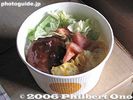
Japanese-style Locomoco, originally from Hawaii208 viewsFrom a well-known bento shop. Not very good.
|
|

Tempura mushroom208 views
|
|

Kokkai means "Black Sea."206 views
|
|

Oil-painted card of river. Apparently by the same artist as the preceding card.205 views
|
|

Ozeki Kotooshu.205 views
|
|
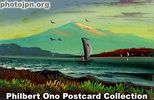
Oil-painted card of ocean and mountain. Apparently by the same artist as the preceding card.204 views
|
|

Each tournament is 15 days long, and each wrestler in the top two divisions wrestle once a day. A wrestler must win at least 8 times during a tournament to get promoted. Otherwise, he is demoted in rank. The more he wins, the higher he is promoted.204 views
|
|

Hakuho throws salt on the sumo ring.204 views
|
|

Okonomiyaki is like a pancake with vegetables and meat.203 views
|
|

Okonomiyaki with sauce and ready to eat. Osaka.203 views
|
|

203 views
|
|
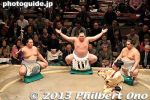
Yokozuna Hakuho202 views
|
|

Pitcher Koji Uehara, originally from the Yomiuri Giants.200 viewsUnfortunately, Daisuke Matsusaka did not pitch this night.
|
|

In the back on the left is a prize from Mexico and one from Hungary on the right. In the front on the left is a prize from Mongolia, middle is from NHK, and right is from China.200 views
|
|
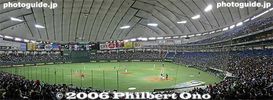
Tokyo Dome199 views
|
|

Okonomiyaki (Osaka)198 views
|
|

Making okonomiyaki198 views
|
|
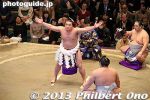
198 views
|
|
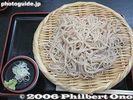
Cold soba noodles196 views
|
|

Laughing Geisha on terrace. It looks like she's on the veranda of a restaurant along a river. If she's a Kyoto geisha, it would be the Kamo River. But these cards were made in Yokohama. I wonder if she was from Yokohama.195 views
|
|

Roho vs. Tochiazuma195 views
|
|
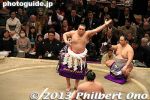
Yokozuna Harumafuji195 views
|
|

Prime Minister's Cup on left, the middle is the President Chirac Award from France, and the glass on the right is a prize from the Czech Republic.194 viewsPresident Chirac is a sumo fan. There is also a Czech wrestler in the lower division.
|
|

Rice with shellfish194 views
|
|
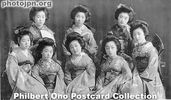
Young girls in kimono.194 views
|
|

One colorful highlight each day during a tournament is the dohyo-iri ring-entering ceremony performed by rikishi in the top two divisions. These are rikishi in the second highest division called Juryo. 十両194 views
|
|

The wrestlers are divided into east and west, and both groups perform the dohyo-iri. They wear colorful ceremonial aprons called kesho mawashi made of silk. They can cost up to 500,000 yen.194 views
|
|

Ozeki Kotooshu with an apron by Bulgaria Yogurt. (Kotooshu is from Bulgaria.)194 views
|
|

Funa-zushi, Shiga Prefecture. Fermented carp.193 views
|
|

On the first day of the tournament, the chairman of the Japan Sumo Association (shown here is Kitanoumi) and top rikishi go on the ring to convey greetings to the crowd.192 views
|
|

There goes Asashoryu.191 views
|
|
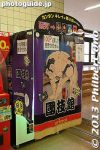
Print Club photo sticker booth.191 views
|
|

Front of Kokugikan. The wide stairs make it quick for many people to exit the building. It is a sleek, modern building with a spacious interior. The roof collects rainwater for use in the toilets.189 views
|
|
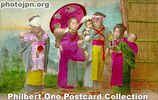
Young baby sitters. The girls look around 8 or 9 years old. The artist went slightly overboard with the hand coloring. Colorful, but too bold.189 views
|
|

Often the wrestlers will lock onto each other while gripping each other's mawashi belts (made of silk). (Ozeki Kaio vs. Tamanoshima in May 2005.)189 views
|
|
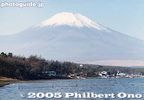
188 views
|
|

188 views
|
|

Prize from the United Arab Emirates.187 views
|
|

The colorful kesho mawashi are expensive to make, and each wrestler has a sponsor who donates an apron. The sponsor's name is usually on the bottom.187 views
|
|

Making okonomiyaki186 views
|
|

Making okonomiyaki184 views
|
|

Takamisakari183 views
|
|

The two rikishi who were called up go on the ring and stomp their foot.180 views
|
|

They glare at each other a few times before the match. They repeat the salt throwing and glaring for four minutes before the match starts.180 views
|
|

There are many sumo techniques (called kimarite) to defeat the opponent. This is okuridashi or rear push out. Once your back is toward the opponent, you have little chance to recover.180 views
|
|
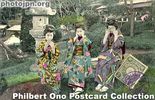
Speak, Hear, and See No Evil. A common pose imitating the monkeys. Postmarked 1914. Hand-colored.178 views
|
|

Then they throw salt onto the ring for purification. They do this a few times before the match. These are all Shinto-based religious rituals. Even the roof above the sumo ring looks like a Shinto shrine roof.178 views
|
|

Next we have the ring-entering ceremony by the top division wrestlers in the Makunouchi Division. Rikishi from the east side come down the aisle first. They are led by a referee.176 views
|
|

Tokyo Dome on March 3, 2006, the first day of the WBC's Asian Round.175 views
|
|
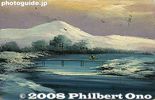
175 views
|
|

The initial charge or tachiai is crucial, and can determine who will win the match. The rikishi on the right has charged earlier than the other, giving him the advantage.175 views
|
|

The sumo tournaments are broadcast live every day on TV by NHK, focusing on the Makunouchi Division matches.174 views
|
|

After the last wrestler is on the ring, they all turn around and raise their arms.173 views
|
|

Overarm throw called uwatenage.173 views
|
|

The referee is thrown into the crowd by the wrestler (by accident, of course). An attendant carries the water bucket out of the way so the referee does not crash into it and spill the water. A judge looks on concerned, while some spectators are amused.173 views
|
|
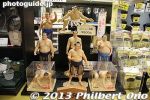
Sumo figurines.173 views
|
|

China at bat.172 views
|
|

Sumo wrestler banners170 views
|
|

Steamed rice with small clams.170 views
|
|

Asashoryu and Hakuho glare at each other.170 views
|
|

China's pitcher and catcher in a conference.169 views
|
|

Kotooshu is from Bulgaria.169 views
|
|

Getting off the sumo ring.167 views
|
|

The rikishi sits at ringside until his name is called by the yobidashi (caller or usher) here who is announcing the wrestler's name while holding a fan.167 views
|
|

Then they rinse their mouths with water for purification. Another wrestler holds the water ladle and tissue paper.167 views
|
|

Takamisakari does his "Robocop" act in his corner to psych himself up.167 views
|
|

On the ring, they spread their arms to show that they carry no weapons.167 views
|
|

Sumo scoreboard. The names of all the wrestlers are displayed in the order of the sumo matches (from right to left). The winner is indicated with a red lamp.167 views
|
|
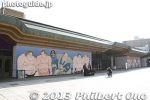
After you go through the ticket gate, the front of Kokugikan has two large murals.167 views
|
|

165 views
|
|

Hakuho, before he became yokozuna.165 views
|
|

Many matches also have sponsor who pay money to the winner of the match. Each banner represents a sponsor.165 views
|
|
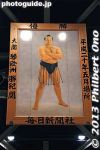
Giant portrait of Ozeki Kotooshu.163 views
|
|

Ichiro at bat. Japan wins 18-2.162 views
|
|

Taiko drum tower162 views
|
|
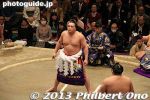
162 views
|
|

Hydrangea161 views
|
|
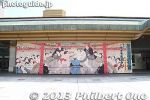
161 views
|
|
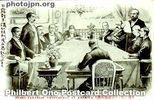
Russo-Japan Peace Conference at Portsmouth. The Japanese delegation headed by Jutaro Komura is on the left and Count Sergei Witte leads the Russian delegation on the right side of the table. The room apparently had a nice view of the ocean.160 viewsAlthough President Roosevelt did not attend the peace conference at Portsmouth, he supervised every detail from Washington and his home on Long Island. Komura was instructed by Tokyo to make sure to obtain a free hand in Korea and control of Southern Manchuria and the railway. Also, for the frosting on the cake, to obtain an indemnity and all of Sakhalin. Japan was in dire financial straits and needed the indemnity to pay for the war and have enough capital for projects in Korea and Manchuria.
Komura got his demands for controlling Korea and Manchuria, but Count Witte rejected demands for an indemnity and Sakhalin. Komura then threatened to walk out of the conference. However, Tokyo told him to compromise. Komura offered to give up on the indemnity if Russia left Sakhalin. Witte accepted and Japan got the southern half of Sakhalin. The Treaty of Postsmouth was signed in Sept. 1905. However, when the Japanese people back home found out that there would be no indemnity, anti-peace rioting occurred. Mobs surrounded the US legation in Tokyo. Komura feared for his life when he returned to Japan.
|
|
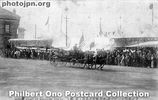
Welcome Parade for the American Fleet. The fleet's crew enjoyed a few days in Japan and was given the red-carpet treatment. A welcoming parade was given in downtown Tokyo around Shimbashi (pictured above) and Hibiya Park.160 viewsA large turnout is apparent in this photo showing a horse-drawn carriage carrying the US and Japanese flags.
American crewmen held Japanese paper umbrellas with a star design, while the Japanese and American flags were everywhere. Japan was highly in favor of peaceful relations with the U.S. The American sailors were surprised and delighted by the friendliness and hospitality of the Japanese.
|
|

Sometimes a match is too close to call. The ringside judges will hold a conference in the ring and either decide who was the winner or declare a rematch. The referee must accept the decision. Judges in the video room may also examine a replay on video.160 views
|
|
|
|

Kokugikan Cafe snack bar159 views
|
|
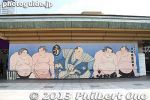
159 views
|
|
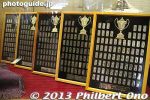
Old Nameplates of tournament winners that were on the Emperor's Cup.159 views
|
|
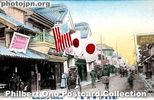
Benten-dori street in Yokohama.158 views
|
|
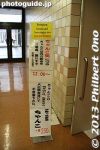
Entrance to the dining room for chanko-nabe. It's downstairs in the basement.158 views
|
|
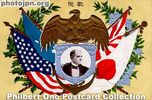
"Great White Fleet" Visiting Japan in Oct. 1908. On Dec. 16, 1907, sixteen U.S. battleships departed Hampton Roads, Virginia for a historic tour around the world. President Theodore Roosevelt was on hand to see the fleet off.157 views"Great White Fleet" Visiting Japan in Oct. 1908. On Dec. 16, 1907, sixteen U.S. battleships departed Hampton Roads, Virginia for a historic tour around the world. President Theodore Roosevelt was on hand to see the fleet off. Dubbed the "Great White Fleet" because of the white-painted hulls of the ships, the powerful flotilla's mission was to promote goodwill and to show any potential enemy (especially Japan) the U.S. Navy's vast naval power.
The fleet was first commanded by Rear Admiral Robley "Fighting Bob" Evans. He later fell ill and was replaced by Rear Admiral Charles Sperry. The person pictured in the postcard is Sperry. A series of postcards were issued by Japan's Department of Communications in commemoration of the fleet's visit to Japan (Yokohama). The card above and below are from this series. The kanji characters above the eagle's head reads "Kangei" which means welcome.
|
|
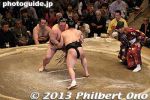
157 views
|
|

The chanko-nabe menu changes a few times during the tournament. The recipes are from various sumo stables.156 views
|
|
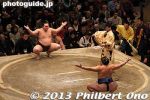
Yokozuna Hakuho vs. Ozeki Kakuryu in Jan 2013. They are both Mongolian.156 views
|
|

Emperor's Cup. This is what all sumo wrestlers dream about.155 views
|
|

Referees are also ranked. The higher ranking referees appear for the matches of the higher-ranking rikishi. They have different dress as the rank goes higher. The lowest-ranked referee may be barefoot.154 views
|
|

Besides Europeans, there are numerous Mongolians in sumo. This is Hakuho in May 2005. He's now a yokozuna.154 views
|
|
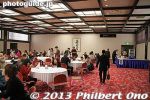
The banquet hall in the basement is used as a dining room during lunch time during tournaments. 大広間154 views
|
|
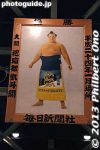
Giant portrait of Baruto154 views
|
|
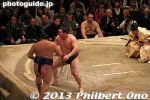
Hakuho beats Kakuryu.154 views
|
|

Iris153 views
|
|
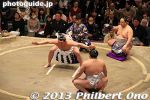
153 views
|
|
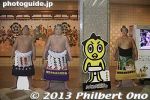
In the entrance hall are life-size cutouts of the top wrestlers.151 views
|
|

Ichiro at bat150 views
|
|
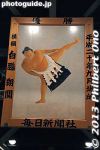
Giant portrait of Yokozuna Hakuho150 views
|
|
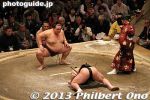
Harumafuji doing his very low stance.150 views
|
|
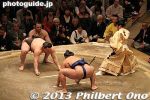
150 views
|
|

Side of lobby. (Passing out free calendar posters during Jan. tourney.)149 views
|
|

Flag painting.149 views
|
|

Fortunately, there are many people who do appreciate sumo, like former French president Jacques Chirac. (THe current French president has no interest in sumo.)149 views
|
|

The cushions are quickly cleared away.149 views
|
|
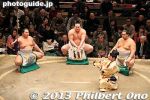
149 views
|
|
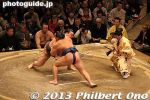
149 views
|
|

Ichiro at bat148 views
|
|

Bulgaria (Kotooshu)148 views
|
|
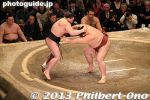
148 views
|
|

147 views
|
|

Child dancer. Postcard-size photograph. Date is unknown.147 views
|
|

This is Hakurozan, who was arrested for drug use in 2008 and booted out of sumo along with his brother Roho.147 views
|
|
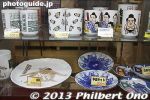
147 views
|
|
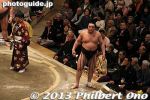
147 views
|
|
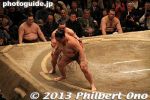
Kisenosato loses this one.147 views
|
|
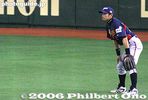
Ichiro in right field.146 views
|
|

Hydrangea146 views
|
|

U.S.S. Mississippi. This was one of the four "black ships" in Commodore Perry 's fleet when he first visited Japan in 1853. This postcard was made to commemorate the construction (in 1901) of the monument (see next postcard) marking Perry�146 viewsU.S.S. Mississippi. This was one of the four "black ships" in Commodore Perry 's fleet when he first visited Japan in 1853. This postcard was made to commemorate the construction (in 1901) of the monument (see next postcard) marking Perry's first landing in Tokyo Bay.
|
|
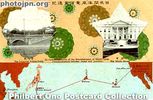
Japan-America Cable Route. With a crudely drawn map, this card shows the route of the undersea cable between Japan and America.146 viewsThe cable extended across the Pacific Ocean via the Bonin Islands (Ogasawara Islands), Guam, Midway, and Hawaii. The cable also connected Japan with the Philippines and Shanghai, China.
On the upper half the card, you see the Imperial Palace on the left and the White House on the right. The caption at the center of the card reads, "In Commemoration of the Establishment of Direct Cable Communication between Japan and America." It's sad to think that these two friendly nations went to war with each other a few decades later.
|
|
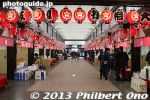
Sumo service entrance for groups.146 views
|
|
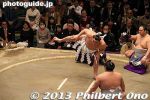
146 views
|
|

Iris145 views
|
|

Hydrangea145 views
|
|

You can see sumo for as cheap as 2100 yen. You can buy tickets at the box office where the tournament is held. The cheap tickets may sell out, so go early.145 views
|
|
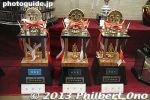
Trophies for the Three Outstanding Prizes (Technique, Outstanding Performance, and Fighting Spirit) from the Japan Sumo Association.145 viewsTechnique Prize (Gino-sho), Outstanding Performance (for most Yokozuna/Ozeki upsets, Shukun-sho), and Fighting Spirit (Kanto-sho).
|
|
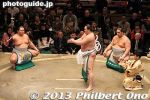
145 views
|
|
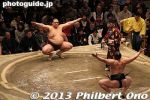
Ozeki Kisenosato vs. Yokozuna Harumafuji in Jan. 2013.145 views
|
|
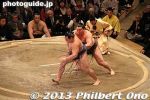
145 views
|
|
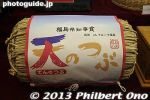
Another prize from Fukushima Prefecture.144 views
|
|
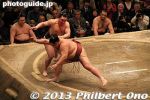
Harumafuji's common technique is to sidestep his opponent and push him out from behind.144 views
|
|

Iris143 views
|
|

Pictured here is one of the U.S. battleships in the fleet. The words "American Fleet" are also spelled out by the anchor rope along the bottom of the photo. The Amphitrite, Puritan, and Montgomery were among the ships making the tour.143 viewsWelcome American Fleet, Oct. 1908
After leaving the U.S., the fleet cruised around South America's Cape Horn, up the U.S. West Coast to San Francisco, across the Pacific Ocean to Hawaii, visited Australia and New Zealand, then stopped in Yokohama, Japan on Oct. 18-24, 1908. Then the fleet sailed across the Indian Ocean, the Suez Canal, the Mediterranean, and the North Atlantic ocean before returning triumphantly to Hampton Roads, Virginia on Feb. 22, 1909. President Roosevelt was there to greet the return of his proud Great White Fleet. It was a 46,000-mile cruise.
It's interesting to note that as a means of long-distance transportation, ships were much more advanced than anything else. Ford's Model T was built in 1908, and the Wright Brothers sold their first flyer (a one-seater) to the U.S. Army in 1909 after a dazzling and record-breaking flight time of 1 hour and 20 min. (altitude: 300 feet).
|
|
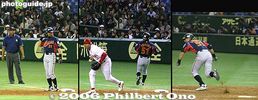
Right to left: Ichiro hits and reaches 1st base.142 views
|
|
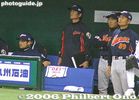
Head coach Sadaharu Oh (extreme right).142 viewsAlso on the left, see Ichiro in the dugout.
|
|

Non-Japanese sumo wrestlers who made it to Makunouchi Division. Four from USA (Hawaii), four from Mongolia, and one from Bulgaria (Kotooshu) as of 2006.142 views
|
|

Bios and pictures of all sumo wrestlers in top Makunouchi division.141 views
|
|

Twins. They look like twins or sisters. Real-photo postcard postmarked 1918.141 views
|
|
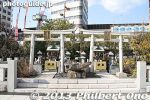
Two small shrines outside.141 views
|
|
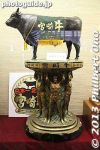
Prize from Miyazaki Prefecture.141 views
|
|

Hydrangea140 views
|
|
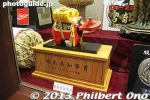
Prize from Fukushima Prefecture.140 views
|
|
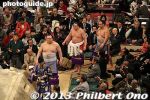
Next is Yokozuna Harumafuji.140 views
|
|

Hydrangea139 views
|
|

German flag on her cheek and the Brazilian flag on her belly.139 views
|
|
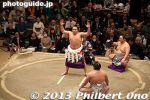
Yokozuna Harumafuji from Mongolia performs the dohyo-iri ring-entering ceremony.139 views
|
|
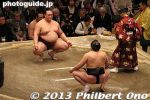
139 views
|
|
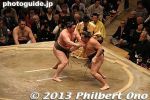
139 views
|
|

138 views
|
|

Gate to enter Kokugikan.137 views
|
|

The bios and pictures are categorized according to prefecture. All wrestlers who were/are active in the modern era are introduced. Two wrestlers from Shiga Prefecture: Kurama and Misugisato.137 views
|
|

Hydrangea137 views
|
|

Cherry Blossoms, Potomac Park, Washington, DC. In this postcard, the Bureau of Engraving and Printing and the U.S. Capitol Dome are in the background. This card was made in the USA in the late 1930s or early 1940s.137 viewsThe cherry trees must be the prettiest and most appreciated gift Japan has ever presented to the United States. The trees are truly a national treasure, for both countries. Today, there are over 3,700 cherry trees accenting Potomac Park and the Washington Monument. They are carefully maintained by arbor specialists.
|
|

The ring-entering ceremony starts at around 4 pm. The yokozuna's rope belt and zig-zag paper streamers look very similar to the sacred rope found at Shinto shrines.137 views
|
|

Rickshaw ride in Yokohama. The caption reads "Navy Musicians enjoying a Rickasha Ride in Yokohama, Japan." Since the card was printed by an American publisher, I'm assuming that they are Americans.136 views
|
|
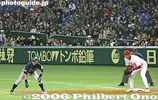
Ichiro at 1st base.135 views
|
|

Iris135 views
|
|

He claps his hands and stomps his foot.135 views
|
|

Tommy Lasorda after throwing the flubbed first pitch.134 viewsHe just threw the ball right on the ground like he wanted to throw it away. It wasn't a pitch at all. What was his problem?
|
|
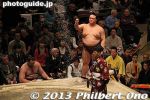
Ozeki Kisenosato134 views
|
|

Autographed as Yoko Aozora. She must have been some kind of teenaged entertainer. Probably a dancer. Looks charming enough.133 views
|
|

Juryo wrestlers performing the ring-entering ceremony.133 views
|
|

Chinese team is introduced.132 views
|
|
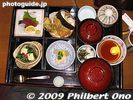
132 views
|
|

JUryo wrestlers continue to fight.130 views
|
|

129 views
|
|
|
|